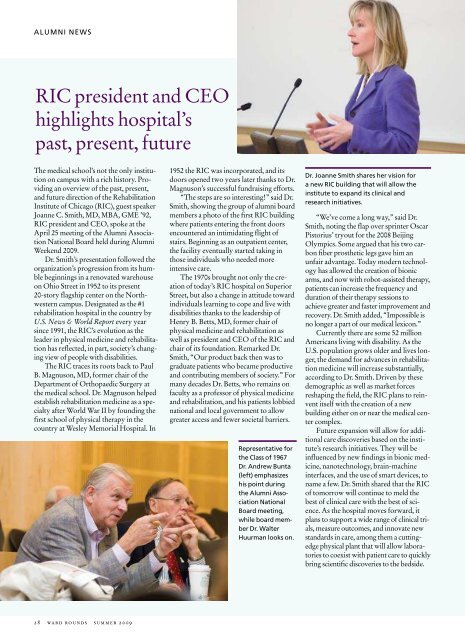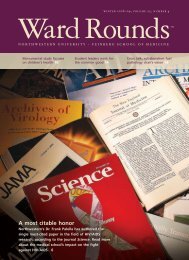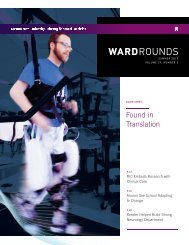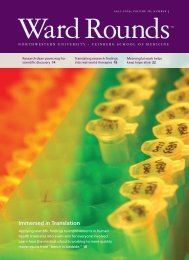Graduation World Tour 2009 - Ward Rounds - Northwestern University
Graduation World Tour 2009 - Ward Rounds - Northwestern University
Graduation World Tour 2009 - Ward Rounds - Northwestern University
Create successful ePaper yourself
Turn your PDF publications into a flip-book with our unique Google optimized e-Paper software.
Alumni NewsRIC president and CEOhighlights hospital’spast, present, futureThe medical school’s not the only institutionon campus with a rich history. Providingan overview of the past, present,and future direction of the RehabilitationInstitute of Chicago (RIC), guest speakerJoanne C. Smith, MD, MBA, GME ’92,RIC president and CEO, spoke at theApril 25 meeting of the Alumni AssociationNational Board held during AlumniWeekend <strong>2009</strong>.Dr. Smith’s presentation followed theorganization’s progression from its humblebeginnings in a renovated warehouseon Ohio Street in 1952 to its present20-story flagship center on the <strong>Northwestern</strong>campus. Designated as the #1rehabilitation hospital in the country byU.S. News & <strong>World</strong> Report every yearsince 1991, the RIC’s evolution as theleader in physical medicine and rehabilitationhas reflected, in part, society’s changingview of people with disabilities.The RIC traces its roots back to PaulB. Magnuson, MD, former chair of theDepartment of Orthopaedic Surgery atthe medical school. Dr. Magnuson helpedestablish rehabilitation medicine as a specialtyafter <strong>World</strong> War II by founding thefirst school of physical therapy in thecountry at Wesley Memorial Hospital. In1952 the RIC was incorporated, and itsdoors opened two years later thanks to Dr.Magnuson’s successful fundraising efforts.“The steps are so interesting!” said Dr.Smith, showing the group of alumni boardmembers a photo of the first RIC buildingwhere patients entering the front doorsencountered an intimidating flight ofstairs. Beginning as an outpatient center,the facility eventually started taking inthose individuals who needed moreintensive care.The 1970s brought not only the creationof today’s RIC hospital on SuperiorStreet, but also a change in attitude towardindividuals learning to cope and live withdisabilities thanks to the leadership ofHenry B. Betts, MD, former chair ofphysical medicine and rehabilitation aswell as president and CEO of the RIC andchair of its foundation. Remarked Dr.Smith, “Our product back then was tograduate patients who became productiveand contributing members of society.” Formany decades Dr. Betts, who remains onfaculty as a professor of physical medicineand rehabilitation, and his patients lobbiednational and local government to allowgreater access and fewer societal barriers.Representative forthe Class of 1967Dr. Andrew Bunta(left) emphasizeshis point duringthe Alumni AssociationNationalBoard meeting,while board memberDr. WalterHuurman looks on.Dr. Joanne Smith shares her vision fora new RIC building that will allow theinstitute to expand its clinical andresearch initiatives.“We’ve come a long way,” said Dr.Smith, noting the flap over sprinter OscarPistorius’ tryout for the 2008 BeijingOlympics. Some argued that his two carbonfiber prosthetic legs gave him anunfair advantage. Today modern technologyhas allowed the creation of bionicarms, and now with robot-assisted therapy,patients can increase the frequency andduration of their therapy sessions toachieve greater and faster improvement andrecovery. Dr. Smith added, “Impossible isno longer a part of our medical lexicon.”Currently there are some 52 millionAmericans living with disability. As theU.S. population grows older and lives longer,the demand for advances in rehabilitationmedicine will increase substantially,according to Dr. Smith. Driven by thesedemographic as well as market forcesreshaping the field, the RIC plans to reinventitself with the creation of a newbuilding either on or near the medical centercomplex.Future expansion will allow for additionalcare discoveries based on the institute’sresearch initiatives. They will beinfluenced by new findings in bionic medicine,nanotechnology, brain-machineinterfaces, and the use of smart devices, toname a few. Dr. Smith shared that the RICof tomorrow will continue to meld thebest of clinical care with the best of science.As the hospital moves forward, itplans to support a wide range of clinical trials,measure outcomes, and innovate newstandards in care, among them a cuttingedgephysical plant that will allow laboratoriesto coexist with patient care to quicklybring scientific discoveries to the bedside.A written and videosummary of theDean’s <strong>2009</strong> State ofthe School Address isavailable online!Find expanded coverage of alumninews at <strong>Ward</strong><strong>Rounds</strong>Online.com.J. Larry Jameson, MD, PhD, vice presidentfor medical affairs and Lewis LandsbergDean of <strong>Northwestern</strong> <strong>University</strong>Feinberg School of Medicine, also spoke tothe group about the state of the school. Henoted that the nation’s economic downturnhas had an impact on the medical schooland that some belt tightening is inevitable.Dean Jameson has made scholarshipsand financial aid one of his priorities tohelp decrease student debt and give<strong>Northwestern</strong> a more competitive edge inattracting students. He also highlightedthe school’s move from 20th to 19th placein the May release of the <strong>2009</strong> U.S. News& <strong>World</strong> Report rankings. “The questionis whether this is a fluctuation or a trend,”said the dean, noting that the school hasheld steady at a ranking of 20 or 21 fornearly a decade. Sharing with the nationalboard the school’s goal to move into thetop 10 of medical schools by 2020, Dr.Jameson expressed some concern over theflattening of research dollars and itsimpact on <strong>Northwestern</strong>.In closing, the dean said that donationsfrom alumni provide a “key fuel forthe medical center,” but that activities suchas mentoring existing students and helpingto attract top students are also invaluable.Ginny Darakjian, assistant dean foralumni affairs, reported that this year’sAlumni Weekend was the best attended todate, with nearly 700 alumni, faculty, students,guests, and staff participating in 31events. During the reunion weekend,incoming alumni board president F.Douglas Carr, MD ’78, replaced Bonnie L.Typlin, MD ’74, with James A. Hill, MD’74, professor of orthopaedic surgery at<strong>Northwestern</strong>, becoming president-elect.The next meeting of the National AlumniAssociation Board will be held October 24.Janet DeRaleauProgress Notes Awards & HonorsIn May the MassachusettsMedicalSociety (MMS)honored Erwin A.Stuebner Jr., MD’70, of Williamstown,Mass., withits <strong>2009</strong> Award forDistinguished Serviceto the society.Recognized for his strong commitment tothe goals of the society, this retired physicianhas been a member of MMS’ board oftrustees and numerous committees andtask forces addressing such issues as pharmaceuticalgifts, hospital closings, andhealth care reform.Sharon Krejci Mowat, MD ’99, ofDanville, Calif., a pediatric hospitalist, waselected medical staff president of KaiserPermanente’s Walnut Creek Medical Centerin Northern California.In AprilMarleta Reynolds,MD, GME ’85,professor of surgeryat <strong>Northwestern</strong>,was appointedsurgeon-in-chiefand head of theDepartment ofSurgery at Children’sMemorial Hospital. Dr. Reynoldshad served on an interim basis in theseroles since last September.The <strong>University</strong> of Mississippi MedicalCenter named Richard C. Boronow, MD’59, of Brandon, Miss., an honorary physicianin 2008.Colby Shad Thaxton, MD ’04, PhD’07, assistant professor of urology at<strong>Northwestern</strong>, was named <strong>2009</strong>Researcher of the Year by Bioscience Technology.Announced in the magazine’s Mayissue, the award recognizes Dr. Thaxtonfor his research using gold nanoparticlesto develop new therapeutics for atherosclerosis.Dr. Thaxton and his team builtartificial nanostructures to mimic HDL,known as good cholesterol, and its cholesterol-removingproperties that take “bad”cholesterol, or LDL, deposits to the liverfor excretion.A. HerbertAlexander, MD’73, of Sun Valley,Idaho, received theJohn R. SealAward from theSociety of MedicalConsultants to theArmed Forces lastOctober inBethesda, Md. The award recognizes outstandingcontributions to military medicinethrough research and patient care. Dr.Alexander also serves as associate editorin-chiefof the American Journal ofOrthopedics.G. Klaud Miller, MD ’75, GME ’78, ofEvanston, Ill., was appointed associateeditor of the Journal of Arthroscopic andRelated Surgery. He has also passed theCertificate of Added Qualification inSports Medicine from the AmericanBoard of Orthopaedic Surgery. Dr. Milleris an assistant professor of clinical orthopaedicsurgery at <strong>Northwestern</strong>.The National Alliance on Mental Illnesspresented James M. Laster, MD ’69,MPH, of Virginia Beach, Va., with theExemplary Psychiatry Award during theannual conference of the American PsychiatricAssociation last year. This awardrecognizes psychiatrists who have “gonethe extra mile” in providing excellent clinicalcare and educating family members,consumers, and the public to reduce thestigma surrounding mental illness. Dr.Laster also received this honor in 1993.Diane E. Wallis, MD ’79, of DownersGrove, Ill., received the American HeartAssociation’s Go Red for Women Awardlast year. This program helps fundresearch, conducts public and professionaleducational programs, and advocates forthe protection of women’s heart health.Alexian Brothers Medical Center inElk Grove Village, Ill., named Daniel M.Sauri, MD ’99, of Chicago its 2008 Physicianof the Year.28 ward rounds summer <strong>2009</strong> wardroundsonline.com 29












